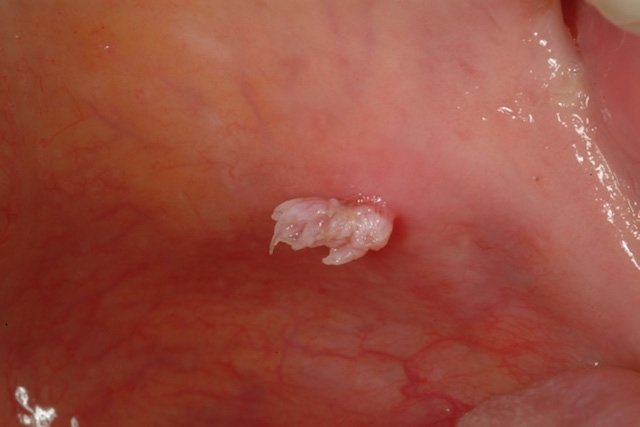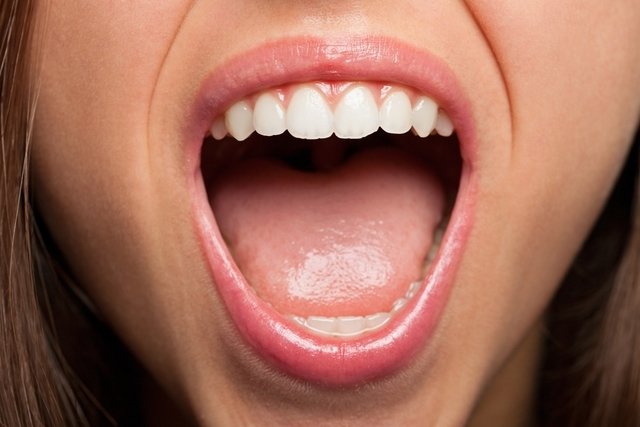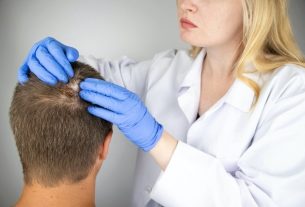HPV in the mouth is infection by the human papilloma virus in the oral mucosa, which generally occurs due to direct contact with genital lesions during unprotected oral sex, with a person infected with HPV, leading to the appearance of symptoms such as lesions or small whitish warts. , frequent canker sores or white or light red sores.
Lesions caused by HPV in the mouth, although rare, are more common on the lateral edge of the tongue, lips and roof of the mouth, but any location on the oral surface can be affected, such as the throat or the base of the tongue.
HPV in the mouth can increase the risk of developing cancer in the mouth, neck or pharynx and, therefore, it is important to consult a general practitioner or stomatologist whenever symptoms of HPV in the mouth appear, so that the diagnosis can be made and treatment can be initiated further. appropriate to prevent the onset of cancer.
Sensitive content
This image may contain content that is uncomfortable for some people

Symptoms of HPV in the mouth
The main symptoms of HPV in the mouth are:
- Lesions or small whitish warts, in the mouth or throat, which can join together and form plaques;
- Wounds that are white, light red or the same color as the skin;
- Frequent canker sores on the edge of the tongue, cheeks or roof of the mouth;
- Constant sore throat;
- Difficulty swallowing;
- Hoarseness;
- Coughing up blood;
- Constant ear pain;
- Soreness in the neck;
- Recurrent sore throat.
Furthermore, most diagnosed cases discover the infection only when more serious complications arise, such as cancer, and other symptoms may also be present, such as weight loss for no apparent reason, swelling or pain in the jaw or swelling in the neck, for example. example.
If HPV symptoms appear in the mouth or if there is a suspicion of being infected with HPV in the mouth, you should consult your general practitioner or stomatologist to confirm the diagnosis and initiate the most appropriate treatment.
How to confirm the diagnosis
The diagnosis of HPV in the mouth is made by a general practitioner or stomatologist through evaluation of symptoms, health history, and observation of lesions in the mouth or throat.
Sometimes it is the dentist who observes a lesion that could indicate an HPV infection during routine dental exams or treatments.
To confirm the diagnosis, the doctor must perform a biopsy to be analyzed in the laboratory, and check the presence of HPV infection, its type and whether the lesion is benign or malignant. See the main tests that detect HPV.
How do you catch HPV in your mouth?
The main way of transmitting HPV to the mouth is through unprotected oral sex, however, it is also possible for transmission to occur through kissing, especially if there is a lesion in the mouth that facilitates the entry of the virus.
Furthermore, HPV infection in the mouth is more common in people who have multiple partners, who smoke or who drink alcohol excessively.
Watch the following video to understand a little more about HPV:
How the treatment is carried out
Many cases of HPV heal without any type of treatment and without causing any symptoms, so it is often the case that the person does not even know they were infected.
However, when lesions appear in the mouth, the treatment indicated by the doctor is generally laser, surgery, cryotherapy, or the use of medications, such as 70 or 90% trichloroacetic acid or interferon alpha, twice a week, for approximately 3 months.
There are 24 types of HPV that can affect the mouth area, not all of which are related to the development of cancer. The types that have a higher risk of malignancy are HPV 16, 18, 31, 33, 35 and 55. Those with medium risk are HPV 45 and 52, and those with low risk are HPV 6, 11, 13 and 32.
After the treatment indicated by the doctor, it is important to carry out other tests to confirm the elimination of the lesions, however, it is very difficult to eliminate the HPV virus from the body and therefore, it cannot always be said that HPV has a cure, because the virus may appear again after some time.
Bibliography
- BETZ, S. J. HPV-Related Papillary Lesions of the Oral Mucosa: A Review. Head Neck Pathol. 13. 1; 80-90, 2019
- ELREFAEY, S. et al.. HPV in oropharyngeal cancer: the basics to know in clinical practice. ACTA Otorhinolaryngologica Italica. Vol.35, no.5. 299-309, 2014
- CDC. HPV and Oropharyngeal Cancer. 2022. Available at: <https://www.cdc.gov/cancer/hpv/basic_info/hpv_oropharyngeal.htm>. Accessed on 02 Dec 2022
- SYRJÄNEN, Stina. Oral manifestations of human papillomavirus infections. European Journal of Oral Sciences. Vol.126, n.1. 49-66, 2018

Sign up for our newsletter and stay up to date with exclusive news
that can transform your routine!
Warning: Undefined array key "title" in /home/storelat/public_html/wp-content/plugins/link-whisper-premium/templates/frontend/related-posts.php on line 12
Warning: Undefined array key "title_tag" in /home/storelat/public_html/wp-content/plugins/link-whisper-premium/templates/frontend/related-posts.php on line 13





